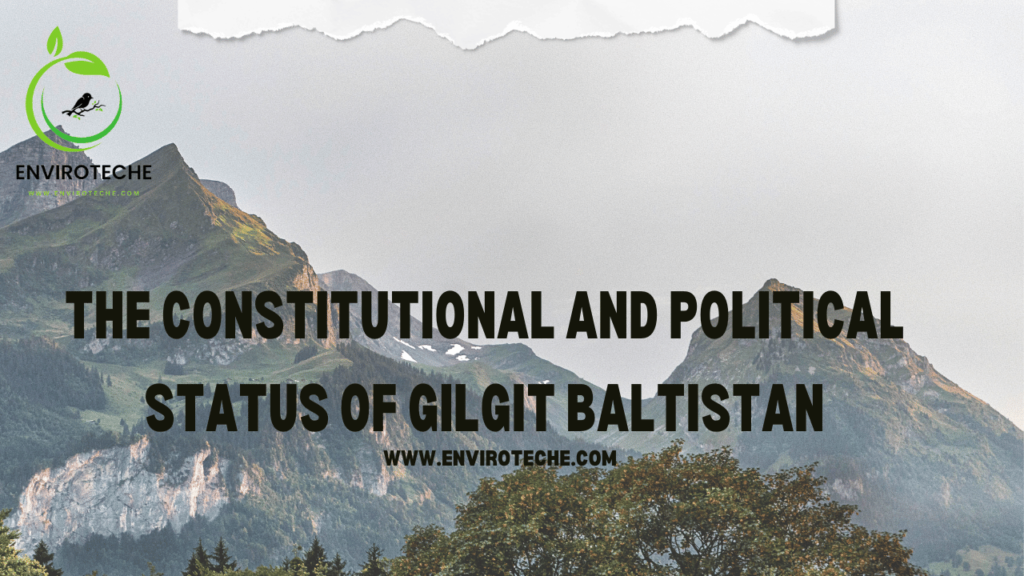
Muhammad Raza1, Muhammad Yaseen2
Department of International Relations, Government College University Faisalabad1
Department of Economics, Government College University Faisalabad2
Abstract:
This essay covers an introduction, historical context, post-independence political and constitutional developments, and challenges to Gilgit Baltistan’s constitutional system. GB, formerly known as the northern territories of Pakistan, is situated in northern Pakistan and shares a border with three different nations: India, China, and Afghanistan. Gilgit-Baltistan, a territory in the Indo-Pak subcontinent, became a part of Pakistan in 1947.
The Muslim Gilgit Scouts conquered the area from the Maharaja of Kashmir’s army on the eve of independence with the help of local leaders, securing independence from the Maharaja of Kashmir. In 1949 Gilgit and Baltistan were temporarily handed over to Pakistan. Since the independence, many reforms were given but the residents of GB are still deprived of fundamental political rights. Some of the fundamental political rights were given to GB in Empowerment and self-governance order 2009. The region has much geostrategic importance therefore India also claims it.
Introduction:
An area in northern Pakistan called Gilgit-Baltistan is well-known for its stunning mountainous scenery and extensive cultural history. It has shared borders with Jammu and Kashmir, ruled by India, the Xinjiang province of China, and the Wakhan Corridor in Afghanistan (Schuurmans, 2023). Historically, the region has played a crucial role as a crossroads for trade routes between South Asia, Central Asia, and China. Gilgit and Skardu are the two main districts, and each has its distinct topography and culture. Gilgit-Baltistan is frequently referred to as the “roof of the world” due to its closeness to mountainous summits, such as K2 (Ali & Akhunzada, 2015).
Historical background:
In 1947, Gilgit-Baltistan, a region in the Indo-Pak subcontinent, saw a unique event when it acceded to Pakistan. Unlike other parts of the subcontinent, there was no widespread movement in Gilgit-Baltistan due to its isolation and geography. However, on the eve of independence, the Muslim Gilgit Scouts, supported by local leaders, liberated the region from the forces of the Maharaja of Kashmir (Sulehria, 2018). This led to the unconditional accession of Gilgit-Baltistan to Pakistan. It briefly declared independence as the “Islamic Republic of Gilgit,” and Syed Shah Rais Khan became its first president, but later became part of the administration of Jammu and Kashmir, and remains a disputed territory between India and Pakistan (AMAN, 2021).
Post-independence reforms in GB:
The agreement reached between Pakistan and Azad Jammu and Kashmir (AJK) in April 1949 resulted in the interim administrative administration of Gilgit and Baltistan being given to Pakistan (Balcerowicz, 2022). The Azad Kashmir Government’s leader was replaced by the Ministry of Kashmir Affairs, which Pakistan had appointed to oversee the area. The Ministry of Kashmir Affairs and Northern Areas (KANA) was founded by Pakistan in 1950, and the local resident administrator was appointed as a joint secretary in 1952(Shahzad et al., 2016).
Elections were used to select the Northern Areas Advisory Council NAAC in 1970, but it had little influence. In 1974, the State of Hunza and the Frontier Crime Regulation were abolished, while new districts of Ghizer and Ganche were established. According to the ruling of the Azad Kashmir High Court (Full Bench) on March 18, 1993, the Northern Areas (Gilgit and Baltistan) are regarded as a component of Azad Kashmir both legally and historically.
The Azad Kashmir High Court has jurisdiction over cases in these fields as well as matters pertaining to Azad Kashmir. The Azad Kashmir government is in charge of establishing administrative and judicial institutions in the Northern Areas. While the Northern Areas are a part of Jammu and Kashmir, Azad
Kashmir does not have administrative jurisdiction over them, according to the ruling of the Azad Kashmir Supreme Court on September 14, 1994, which was made in opposition to the ruling of the High Court on March 18, 1993. The Legal Framework Order of 1994, which also brought about reforms, established the Chief Secretary, Civil Secretariats, and judicial amendments. The Chief Court may appoint a District Session Judge from the Northern Areas or senior judges from the Federal Court or Provincial High Court (IMTIAZ-UL-HAQUE, 2012).
The 2009 Gilgit-Baltistan Empowerment and Self-Government Order:
The Gilgit-Baltistan Empowerment and Self Governance Order 2009 was adopted in August 2009 to give Gilgit-Baltistan internal autonomy and put it equal with Pakistani provinces while denying it provincial recognition. The setup in Azad Kashmir and the regional settings in Pakistan had an impact on this arrangement, which was an improvement above earlier frameworks (Holden, 2019). The order was created by a committee made up of various government representatives and chaired by the Minister for Kashmir Affairs and Northern Areas. The Cabinet examined and approved the draught reforms (Hussain, 2014).
Several modifications were made as a result of the Gilgit-Baltistan Empowerment and Self-governance Order of 2009. The area that had been referred to as the Northern Areas has been renamed Gilgit-Baltistan. There are now offices for the governor, chief minister, and ministers (Lambah, 2016). Similar to the AJK Council, the PM of Pakistan will preside above the Gilgit-Baltistan Council. The Gilgit-Baltistan Assembly was given extended legislative jurisdiction over 61 subjects as well as the ability to approve budgets. Additionally, the Gilgit-Baltistan Council was given legislative control over 55 topics. These changes aimed to provide Gilgit-Baltistan with more autonomy and self-governance (Zaheer, 2018).
Hurdles in Constitutional Status:
The status of Gilgit-Baltistan is related to the more general problem of Jammu and Kashmir, which is a disputed region. Giving Gilgit-Baltistan provincial status might aggravate an already controversial situation and have an impact on international relations, notably with India, which also asserts sovereignty over the area (Howe & Hunzai, 2019).
The area is strategically positioned, and several nations have stakes in it. The granting of provincial status might hurt the delicate balance of power in the region and would not be well received by the surrounding nations. A clear road to awarding Gilgit-Baltistan provincial status is not offered by Pakistan’s current legal and constitutional structure. The establishment of the requisite judicial and institutional frameworks for provincial governance would necessitate amendments (Shahid & Gerster, 2019).
Conclusion:
Since its incorporation into Pakistan in 1947, Gilgit-Baltistan, an area with a rich historical heritage, has had a contentious constitutional and political situation. The Gilgit-Baltistan Empowerment and Self-Governance Order of 2009 is only one of the numerous political and constitutional reforms that have taken place in the region over the years.
Even though these changes gave the locals some political rights, there are still worries among the citizens about the execution of their constitutional rights. Due to the contested status of the area and its geopolitical significance, it is a complicated problem. The fact that India also asserts its sovereignty over Gilgit-Baltistan complicates matters further. The issue is made more complicated by the region’s geopolitical importance due to its placement at the crossroads of Pakistan, China, Afghanistan, and India.
A balanced strategy that takes into account the desires of the local population, geopolitical variables, and adherence to international legal frameworks is required to resolve these complications. The process for implementing constitutional reforms should be broad and thorough, taking into consideration the worries of all interested parties and preserving regional stability.
References:
Ali, S. W., & Akhunzada, T. (2015). Unheard voices: engaging youth of Gilgit-Baltistan. London, UK: Conciliation Resources.
AMAN, N. (2021). Religion and Citizenship Education in Pakistan: The Case of Gilgit-Baltistan. Doctoral dissertation, University of Hong Kong.
Balcerowicz, P. (2022). Pakistan vis-à-vis Gilgit-Baltistan. In Law and Conflict Resolution in Kashmir (pp. 50–67). Routledge.
Holden, L. (2019). Law, governance, and culture in Gilgit-Baltistan: introduction. South Asian History and Culture, 10(1), 1–13.
Howe, K., & Hunzai, I. (2019). The politics of exclusion. South Asian History and Culture, 10(1), 14–27.
Hussain, Y. (2014). Social media as a tool for transparency and good governance in the government of Gilgit-Baltistan, Pakistan.
IMTIAZ-UL-HAQUE, C. (2012). DETERMINING THE POLITICAL STATUS OFGILGIT-BALTISTAN–FUTURE PERSPECTIVE. NATIONAL UNIVERSITY OF MODERN LANGUAGES.
Lambah, S. K. (2016). The tragic history of Gilgit-Baltistan since 1947. Indian Foreign Affairs Journal, 11(3), 227–237.
Schuurmans, L. (2023). Azaadi, Freedom and Change in Kashmir. Arena Books. political
Shahid, Z., & Gerster, M. (2019). Subnational Empowerment for a Cohesive Federation. A Country Study of Constitutional Asymmetry in Pakistan. Constitutional Asymmetry in Multinational Federalism: Managing Multinationalism in Multi-Tiered Systems, 369–398. political
Shahzad, M. S., Akram, S. A., & Hashmi, S. B. H. (2016). AZAD JAMMU AND KASHMIR AND GILGIT BALTISTAN: HISTORICAL, CONSTITUTIONAL & ADMINISTRATIVE DEVELOPMENT. Journal of Contemporary Studies, 5(1), 69–85. political
Sulehria, F. (2018). Kashmir as Partition’s ‘unfinished business.’ In Partition of India (pp. 193–208). Routledge India. political
Zaheer, M. A. (2018). Constitutional Developments and Challenges to Autonomous and Self-governing System of Gilgit-Biltistan. Journal of Indian Studies, 4(2), 253–261. political
Check Other Schlorships:
